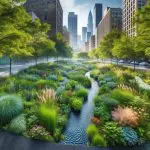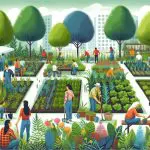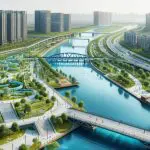
Dive into the world of Nature-Based Solutions in Urban Design, where green innovation meets urban resilience. Explore how nature transforms cities!
Nature-Based Solutions in Urban Design
Key Takeaways:
- Nature-based solutions in Urban Design integrate natural elements into urban environments to tackle environmental and social challenges.
- They include green roofs, parks, and rain gardens, enhancing biodiversity, and air quality, and reducing the urban heat island effect, ultimately leading to healthier, more sustainable cities.
Welcome to the green revolution in cityscapes! Nature-based solutions in Urban Design are reshaping our urban environments, blending natural elements with urban planning.
Discover how these innovative approaches are not just beautifying our cities, but also tackling environmental challenges, enhancing biodiversity, and improving the quality of life for urban residents.
Let’s explore the fusion of nature and design in creating sustainable, livable cities.
Introduction to Nature-Based Solutions in Urban Design
Explore how Nature-Based Solutions (NbS) in urban planning are revolutionizing our cities.
From enhancing public health to tackling environmental challenges, NbS are pivotal in creating resilient and sustainable urban spaces, offering a myriad of benefits for urban residents and the local economy.
The Role of NbS in Urban Planning and Design
Urban planning and design are at a crossroads, facing significant environmental challenges.
NbS offers transformative solutions, improving urban quality of life and green infrastructure.
Discover how NbS shape urban resilience and address pressing urban challenges.
Defining NbS in Urban Contexts
Nature-based solutions (NbS) in urban planning refer to strategies that integrate natural elements and processes into the urban landscape.
These solutions are designed to address various urban challenges, including environmental and social issues, by harnessing the benefits of natural ecosystems.
The concept of NbS is grounded in the idea that nature can provide effective and efficient solutions to many urban problems, from air pollution to urban heat islands, while also enhancing public health and the local economy.
Key Aspects of NbS in Urban Planning:
- Integration of Natural Elements: This involves incorporating features like green roofs, urban parks, rain gardens, and green walls into urban areas.
- Ecosystem Services: NbS capitalizes on the services provided by natural ecosystems, such as air and water purification, flood control, and temperature regulation.
- Biodiversity Enhancement: By introducing and preserving natural habitats, NbS contributes to urban biodiversity, supporting a variety of flora and fauna.
- Socio-Economic Benefits: Beyond environmental advantages, NbS offers economic benefits, such as increased property values and opportunities for local businesses, while also improving social cohesion and community well-being.
Enhancing Green Infrastructure for Urban Resilience
Green infrastructure is a critical component of urban resilience, offering a strategic approach to managing environmental challenges in cities.
It encompasses a network of natural and semi-natural areas, including parks, greenways, rivers, and constructed features like green roofs and walls, that work together to deliver a wide range of ecosystem services.
Importance of Green Infrastructure in Urban Resilience:
- Climate Change Mitigation and Adaptation: Green infrastructure plays a vital role in mitigating the impacts of climate change by sequestering carbon and providing cooling effects, thus reducing the urban heat island effect.
- Stormwater Management: Naturalized areas like rain gardens and permeable surfaces help manage stormwater, reducing flood risks and improving water quality.
- Urban Heat Reduction: Trees and vegetation in urban settings provide shade and cooling, essential in densely built environments.
- Enhanced Public Spaces: Green infrastructure contributes to the quality of life by offering recreational and aesthetic value to urban residents.
Strategies for Implementing Green Infrastructure:
- Policy Initiatives: City governments can develop policies that promote the incorporation of green infrastructure in both public and private developments.
- Community Engagement: Involving local communities in the planning and maintenance of green spaces ensures that the solutions meet the needs and preferences of urban residents.
- Public-Private Partnerships: Collaboration between city authorities, businesses, and NGOs can facilitate the development and maintenance of green infrastructure.
- Innovative Design Solutions: Encouraging creative design approaches that integrate green spaces into the urban fabric, such as rooftop gardens, urban forests, and blue infrastructure like ponds and streams.
Green Roofs: A Key Element in Urban Sustainability
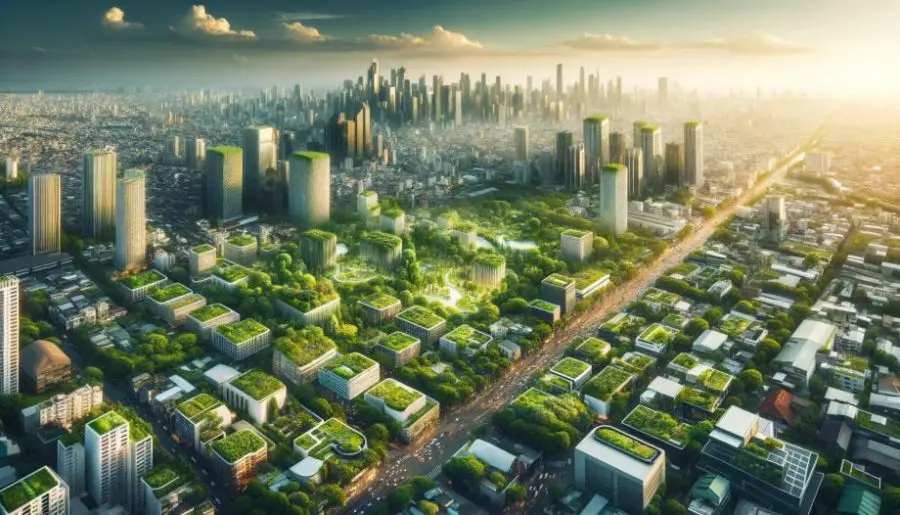
Green roofs symbolize innovative urban sustainability. In this section, uncover how these green infrastructures contribute to environmental and economic benefits, and enhance public health in urban settings.
Benefits and Challenges of Green Roofs
Green roofs, an integral part of urban green infrastructure, offer numerous benefits and face certain challenges in their implementation.
Benefits of Green Roofs:
- Environmental Benefits: They reduce the urban heat island effect, improve air quality, and increase biodiversity by providing habitats for wildlife.
- Stormwater Management: Green roofs absorb rainwater, reducing runoff and mitigating flood risks.
- Energy Efficiency: By providing insulation, green roofs help in reducing the energy needed for heating or cooling buildings.
- Aesthetic and Recreational Value: They enhance the visual appeal of buildings and provide recreational spaces for urban residents.
- Economic Benefits: Green roofs can increase property values and have longer lifespans compared to conventional roofs, offering long-term economic advantages.
Challenges of Green Roofs:
- High Initial Costs: The installation of green roofs can be expensive, although these costs can be offset by long-term savings.
- Maintenance Requirements: Regular maintenance is necessary to ensure the health and functionality of the vegetation.
- Structural Requirements: Buildings need to be evaluated for their ability to support the additional weight of a green roof.
- Knowledge and Expertise: Successful implementation requires specific horticultural and engineering knowledge.
Case Studies: Successful Green Roof Implementations
Several cities around the world have successfully implemented green roofs, showcasing their adaptability and benefits in different urban contexts.
- City Hall, Chicago, USA: The City Hall of Chicago boasts an extensive green roof, which has become a model for other cities. It demonstrates how green roofs can be integrated into existing buildings, contributing to urban sustainability and biodiversity.
- Gardens by the Bay, Singapore: This iconic project features extensive green roofing, blending urban life with nature. It showcases the role of green roofs in enhancing the city’s green footprint and attracting tourism.
- Copenhagen, Denmark: Copenhagen’s policy mandates green roofs in all new building projects. This initiative has significantly increased green space in the urban area, showcasing how policy can drive the widespread adoption of green roofs.
Table 1: Benefits and Challenges of Green Roofs
| Benefits | Challenges |
|---|---|
| Reduction of urban heat island effect | High initial installation costs |
| Improvement in air quality | Regular maintenance requirements |
| Enhanced building insulation | Structural requirements for buildings |
| Stormwater management | Need for specific horticultural knowledge |
| Creation of habitats for biodiversity | |
| Aesthetic improvement and recreation | |
| Long-term economic advantages |
These case studies from Chicago, Singapore, and Copenhagen highlight the diverse applications of green roofs and their potential to address various urban environmental challenges.
They serve as exemplary models for cities worldwide looking to enhance their urban landscapes and sustainability through green roofing solutions.
The Impact of Local Governments in Promoting NbS
Local governments play a substantial role in implementing NbS. Explore their strategies for promoting green urban landscapes and addressing social and environmental issues in urban areas.
Policy and Governance of NbS
Implementing Nature-Based Solutions (NbS) effectively requires robust policy frameworks and governance structures.
This involves integrating NbS into urban planning and environmental policies, ensuring they align with broader sustainability goals.
Key Aspects of Policy and Governance:
- Policy Integration: Effective NbS require policies that integrate them into urban planning, environmental management, and climate adaptation strategies. This involves creating supportive legal and regulatory frameworks that encourage NbS adoption.
- Funding and Incentives: Allocating sufficient funding and providing incentives for NbS projects are crucial. This might include grants, tax breaks, or other financial incentives to encourage both public and private sector engagement.
- Multi-level Governance: NbS implementation involves coordination across different levels of government—from local to national—to ensure coherent policy approaches and resource allocation.
- Monitoring and Evaluation: Establishing mechanisms for monitoring and evaluating NbS projects helps in assessing their effectiveness and guides future policy adjustments.
Collaborative Efforts Between City Governments and Local Communities
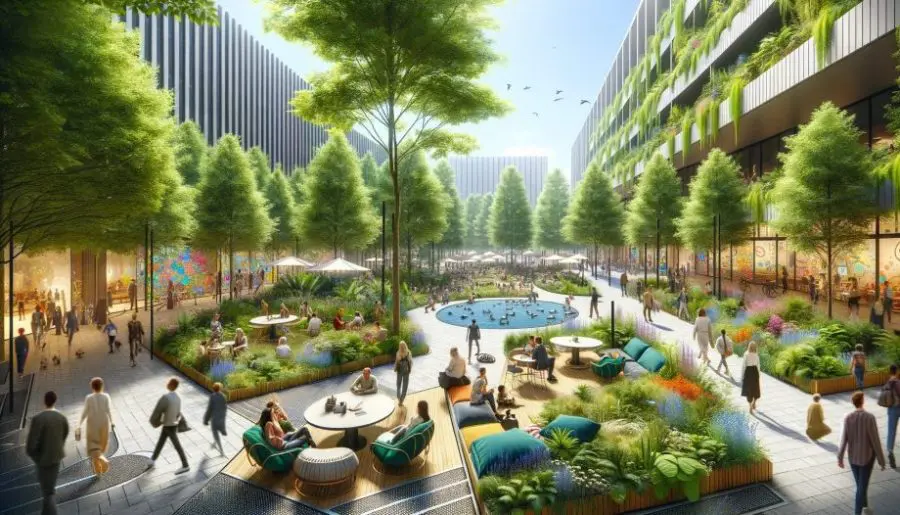
Collaboration between city governments and local communities is vital for the success of NbS.
These partnerships ensure that NbS are well-suited to local contexts and address the specific needs and preferences of urban residents.
Strategies for Effective Collaboration:
- Community Engagement: Actively involving local communities in the planning, design, and implementation of NbS ensures that these solutions are grounded in local needs and knowledge. This can be achieved through public consultations, participatory planning sessions, and community workshops.
- Partnerships with NGOs and Businesses: Forming partnerships with NGOs, local businesses, and other stakeholders can bring in additional expertise, resources, and perspectives. These partnerships can help in project implementation, maintenance, and funding.
- Educational Programs and Awareness Campaigns: Educating residents about the benefits of NbS and how to participate in their development and upkeep fosters a sense of ownership and responsibility towards these projects.
- Volunteer Programs: Encouraging volunteerism in NbS projects, such as community gardens or tree planting initiatives, enhances community engagement and fosters a deeper connection with the local environment.
These strategies highlight the importance of policy and governance structures that support NbS and the value of collaborative efforts in ensuring their success.
By involving multiple stakeholders and ensuring well-structured policies, cities can effectively implement NbS that are beneficial, sustainable, and widely supported.
Tackling Urban Challenges with NbS
Urban challenges, from air pollution to urban sprawl, demand innovative solutions.
NbS offers inclusive, ecosystem-based approaches to improve the resilience of urban areas and enhance human well-being.
Addressing Environmental and Social Challenges through NbS
Nature-based solutions (NbS) are crucial in tackling both environmental and social challenges in urban areas, offering holistic and sustainable approaches.
Environmental Challenges:
- Biodiversity Conservation: NbS, like urban parks and green corridors, create habitats for local wildlife, helping to preserve biodiversity.
- Air and Water Quality Improvement: Plant-based solutions like green roofs and urban forests improve air quality by filtering pollutants and enhancing water quality through natural filtration systems.
- Climate Change Mitigation: By sequestering carbon and restoring natural ecosystems, NbS plays a significant role in combating climate change.
Social Challenges:
- Health and Well-being: Access to green spaces is linked to improved mental and physical health. NbS like community gardens and urban parks provide recreational and therapeutic benefits to urban residents.
- Community Building and Social Inclusion: NbS projects often foster community engagement and social cohesion, providing inclusive spaces for interaction and leisure.
- Economic Opportunities: NbS can stimulate local economies by creating green jobs and boosting property values.
Urban Heat Island Effect and NbS Interventions
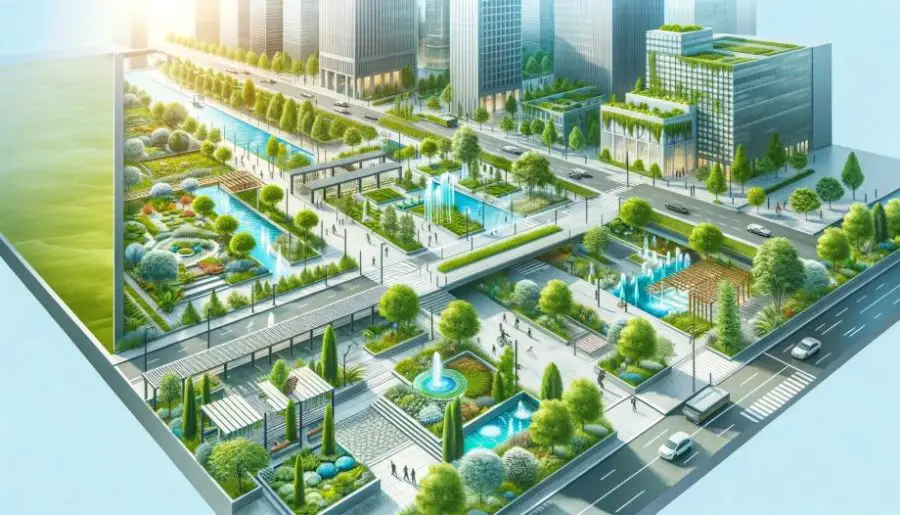
The Urban Heat Island (UHI) effect, where urban areas experience higher temperatures than their rural surroundings, is a growing concern. NbS are effective interventions to mitigate this effect.
NbS Interventions for UHI Mitigation:
- Tree Planting and Urban Forestry: Trees and vegetation provide shade and evaporative cooling, significantly reducing urban temperatures.
- Green Roofs and Walls: These structures absorb sunlight and heat, helping to cool buildings and the surrounding air.
- Water-Based Solutions: Features like ponds, fountains, and rain gardens can lower local temperatures through evaporative cooling.
- Permeable Pavements: These allow water to percolate into the ground, reducing surface temperatures and mitigating the UHI effect.
By addressing environmental and social challenges and mitigating the UHI effect, NbS proves to be a versatile and effective tool for enhancing urban sustainability and resilience.
These interventions not only improve the quality of urban environments but also contribute to the overall well-being of urban communities.
NbS and Public Health: A Vital Connection
Public health and urban environments are closely linked. This section delves into how NbS in urban landscapes contributes to improved air quality, reduced disaster risks, and overall human health enhancement.
Table 2: Economic and Environmental Benefits of NbS
| Economic Benefits | Environmental Benefits |
|---|---|
| Increase in property values | Improvement in air and water quality |
| Job creation in green sectors | Reduction of urban heat island effect |
| Attraction of tourism and recreation | Carbon sequestration and climate mitigation |
| Long-term cost savings in urban management | Conservation and enhancement of biodiversity |
| Stimulation of local businesses | Natural stormwater and flood management |
Urban Green Spaces and Health Benefits
Urban green spaces are vital for public health, offering numerous physical and mental health benefits to city dwellers.
Physical Health Benefits:
- Air Quality Improvement: Trees and plants in urban green spaces help filter pollutants and improve air quality, reducing respiratory problems.
- Physical Activity: Parks and green areas encourage physical activities such as walking, jogging, and cycling, contributing to overall physical health.
- Heat Mitigation: Green spaces provide cooler areas in cities, which is essential during heatwaves and helps prevent heat-related illnesses.
Mental Health Benefits:
- Stress Reduction: Natural settings are known to reduce stress levels and enhance mood. Access to green spaces offers a calming environment away from the urban hustle.
- Cognitive Benefits: Studies show that spending time in green spaces can improve concentration, memory, and cognitive function.
- Social Interaction: Green spaces provide community gathering spots, fostering social connections and combatting loneliness and social isolation.
Case Studies: NbS Improving Public Health
Several case studies around the world highlight the positive impact of NbS on public health.
- High Line Park, New York City, USA: This elevated linear park, built on a historic freight rail line, offers a unique green retreat in the heart of Manhattan. It provides not only a place for physical activity but also a serene environment contributing to mental well-being.
- Lee Valley Regional Park, London, United Kingdom: Spanning 10,000 acres, this park has significantly improved the health and well-being of the local community by providing extensive green space for recreation, sports, and leisure activities.
- The Cheonggyecheon Stream Restoration, Seoul, South Korea: This project transformed an overpass into a vibrant, green public space. It has been linked to improved mental health outcomes for nearby residents, as well as an increase in biodiversity and improved air quality.
These case studies demonstrate how well-planned NbS can have a profound impact on urban public health, enhancing both the physical and mental well-being of urban residents.
Economic and Environmental Benefits of NbS
NbS interventions are not just environmentally sound but economically beneficial. Discover the economic activity stimulated by NbS and its role in sustainable urban development.
Cost-Benefit Analysis of NbS Implementations
Evaluating the cost-effectiveness of Nature-Based Solutions (NbS) is crucial for understanding their economic viability and long-term sustainability.
Key Considerations in Cost-Benefit Analysis:
- Initial Investment and Long-Term Savings: Although NbS can require significant upfront investment, they often lead to substantial long-term savings. For example, green roofs may have higher initial costs but can reduce energy bills and stormwater management expenses.
- Ecosystem Services Valuation: Assessing the economic value of ecosystem services provided by NbS, such as air and water purification, flood prevention, and carbon sequestration, is essential in the analysis.
- Health Cost Reduction: NbS contributes to public health improvements, which can lead to reduced healthcare costs.
- Resilience to Climate Change Impacts: By mitigating effects like flooding and heat waves, NbS can save costs associated with climate change-related damages.
Green Infrastructure’s Role in the Local Economy
Green infrastructure significantly contributes to the local economy, offering diverse economic benefits.
Economic Benefits of Green Infrastructure:
- Job Creation: The development and maintenance of green infrastructure create jobs in sectors like landscaping, horticulture, and environmental management.
- Property Value Enhancement: Properties near green spaces often have higher values. Well-maintained parks and green amenities can boost the attractiveness and value of neighborhoods.
- Tourism and Recreation: Green spaces and well-designed NbS can attract tourists and locals, contributing to the local economy through recreational spending.
- Local Business Support: Green infrastructure projects can stimulate local businesses, including nurseries, gardening services, and eco-friendly construction companies.
By conducting comprehensive cost-benefit analyses and recognizing the multifaceted economic impacts of green infrastructure, city planners and stakeholders can make informed decisions that support sustainable and economically viable urban development.
Case Studies of Successful NbS Implementations

Explore diverse case studies of NbS implementations across the globe. From European cities to the global south, witness how NbS are transforming urban life at different scales.
European Commission and United Nations Backed Projects
Projects backed by the European Commission and the United Nations often set benchmarks for NbS worldwide, showcasing innovative approaches and successful outcomes.
European Commission-Backed Projects:
- LIFE Program: The EU’s funding instrument for the environment and climate action supports numerous NbS projects focusing on biodiversity, climate change adaptation, and environmental policy development.
- Horizon 2020: This EU research and innovation program has funded projects integrating NbS for sustainable urban development, focusing on enhancing urban biodiversity and green infrastructure.
United Nations-Backed Projects:
- UN Environment Programme: UNEP supports NbS initiatives that address environmental challenges while promoting sustainable urban living.
- UN-Habitat: This program focuses on sustainable urban development, with projects that incorporate NbS to improve urban resilience, particularly in cities facing rapid urbanization and environmental stress.
Success Stories from New York to the United Kingdom
Numerous cities from New York to the United Kingdom have implemented NbS with remarkable success, becoming models for urban sustainability.
New York, USA:
- High Line Park: An exemplary transformation of an old railway line into an elevated green urban space. It has become a symbol of innovative urban redevelopment and green space provision.
- Billion Oyster Project: This initiative focuses on restoring oyster reefs to New York Harbor, improving water quality and promoting biodiversity.
United Kingdom:
- London’s Queen Elizabeth Olympic Park: Post-2012 Olympics, this park was developed into a sustainable landscape, demonstrating large-scale NbS integration in an urban setting.
- The Eden Project, Cornwall: An educational facility that showcases different global ecosystems. It highlights how NbS can be utilized for environmental education and conservation.
Table 3: Comparison of NbS Implementations in Different Urban Contexts
| City/Region | Type of NbS Implementation | Key Benefits |
|---|---|---|
| New York, USA | High Line Park, Billion Oyster Project | Recreational space, biodiversity, water quality improvement |
| Copenhagen, Denmark | Mandatory green roofs in new buildings | Urban cooling, biodiversity, aesthetic improvement |
| London, UK | Queen Elizabeth Olympic Park | Sustainable landscape, recreational area |
| Seoul, South Korea | Cheonggyecheon Stream Restoration | Improved mental health, air quality, biodiversity |
| Singapore | Gardens by the Bay, Green Roofs | Tourism attraction, urban sustainability |
These projects demonstrate the wide-ranging impact of NbS from ecological restoration to urban park development, offering valuable insights for future urban planning and sustainability initiatives.
NbS in Urban Design FAQs
Have questions about NbS and urban design? Our FAQ section covers common inquiries, providing clear, concise answers to deepen your understanding of NbS in urban contexts.
Q: What are Nature-Based Solutions in urban planning?
A: Nature-based solutions in urban planning involve using natural elements and processes to address urban environmental and social challenges.
Examples include creating parks, green roofs, and rain gardens to improve biodiversity, air and water quality, and mitigate climate change effects.
Q: How do green roofs benefit cities?
A: Green roofs benefit cities by reducing the urban heat island effect, improving air quality, managing stormwater, and providing recreational spaces.
They also enhance biodiversity, increase aesthetic appeal, and can lead to energy savings for buildings.
Q: What role do local governments play in NbS implementation?
A: Local governments are crucial in NbS implementation. They create policies, provide funding, and oversee projects that integrate NbS into urban landscapes.
They also engage with communities, support research and development, and collaborate with various stakeholders to ensure successful implementation.
Q: Can NbS help in reducing urban flood risks?
A: Yes, NbS can significantly reduce urban flood risks. By incorporating features like rain gardens, permeable pavements, and restored wetlands, cities can manage stormwater more effectively, reducing the likelihood and impact of flooding.
Q: Are there economic benefits to implementing NbS in urban areas?
A: Absolutely. NbS offers economic benefits such as increasing property values, creating green jobs, and attracting tourism.
They also reduce long-term environmental management costs and contribute to healthier, more livable cities, which can drive economic growth.
Q: How do NbS impact urban biodiversity?
A: NbS greatly enhances urban biodiversity by creating habitats for various species.
Urban parks, green corridors, and rooftop gardens can provide havens for birds, insects, and other wildlife, contributing to a richer, more diverse urban ecosystem.
Q: What challenges are associated with NbS implementation?
A: The challenges include securing adequate funding, ensuring appropriate maintenance, integrating NbS into existing urban infrastructures, and addressing the potential lack of public awareness or support.
Balancing development needs with conservation is also a key challenge.
Nature-Based Solutions in Urban Design Conclusion
In conclusion, this blog post has delved into the dynamic world of Nature-Based Solutions (NbS) in urban planning, highlighting their pivotal role in addressing contemporary environmental and social challenges in our cities.
We’ve explored how NbS, such as green roofs, urban parks, and rain gardens, not only enhance biodiversity and improve air and water quality but also contribute significantly to the well-being of urban residents.
Key points from our discussion include:
- The definition and importance of NbS in urban contexts.
- The various benefits and challenges associated with green roofs.
- The crucial role of local governments in implementing and governing NbS.
- NbS is a tool for tackling urban challenges like the urban heat island effect.
- The positive impact of NbS on public health and the local economy.
- Inspiring case studies from around the world, from New York to the United Kingdom, demonstrating the successful implementation of NbS.
- The economic analysis of NbS, reveals its cost-effectiveness and long-term financial benefits.
The transformative potential of NbS in urban environments is undeniable.
They offer a path towards more sustainable, resilient, and biodiverse urban spaces, showcasing a harmonious blend of nature and urban living.
By adopting NbS, cities can not only address immediate environmental and social challenges but also lay the groundwork for a sustainable and prosperous future.
Read more: Green vs Gray Infrastructure – Sustainably Forward

